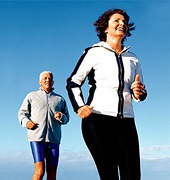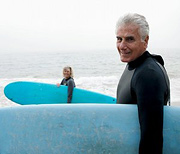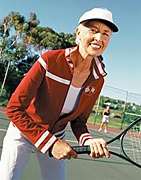Staying Active While Aging
By Julie Engebretson
Fitness matters, especially as we age. Here's a refresher course on the importance of regular physical activity and its role in preventing disease and injury in your later years. It's no secret that exercise is important, especially as we age. We learn this early in life: Young people throughout America are required to take physical education classes from first grade through high school, as has been the case for decades. But has the "get moving" message from those P.E. classes stayed with you? As you turned your tassel from left to right on graduation day, you may have said goodbye to coaches, gym lockers and formal physical education, but commencement "exercises" shouldn't be your last! Among the many factors that do a body good, maintaining cardiovascular fitness and lean muscle mass while aging is somewhere at the top of the list. Challenging the natural loss of vitality over our lifetime with consistent physical activity not only keeps excess weight off, but also boosts immunity and mood, and has been shown to promote heart health, delay or prevent osteoporosis and even prevent some types of cancer. But instead of another shaming, finger-waving reminder that you ought to hit the gym more often, perhaps a closer look at the very real consequences of inactivity will provide the motivation you need to get moving. Inactivity: The Heart Of The Matter.
 Physical activity or inactivity affects heart health more than you may be aware. More than just a pump, the human heart is responsible for nourishing every cell in the body, carrying vital materials such as oxygen and glucose throughout the body, while waste and unnecessary products are removed. But as we age, the heart's job can be made much more difficult. Decades of poor eating and inactivity allow plaque (deposits of fatty substances, cholesterol, calcium and other matter) to plaster the walls of arteries that supply blood to the heart muscle. This process considerably narrows the passageways through which blood must pass.
Physical activity or inactivity affects heart health more than you may be aware. More than just a pump, the human heart is responsible for nourishing every cell in the body, carrying vital materials such as oxygen and glucose throughout the body, while waste and unnecessary products are removed. But as we age, the heart's job can be made much more difficult. Decades of poor eating and inactivity allow plaque (deposits of fatty substances, cholesterol, calcium and other matter) to plaster the walls of arteries that supply blood to the heart muscle. This process considerably narrows the passageways through which blood must pass. A unique trait of the cardiac muscle is that, unlike skeletal muscles, the heart cannot vary the amount of force or energy exerted from beat to beat. In keeping with our fitness theme, lying back on the bench press, the average man is capable of completing 10 repetitions fairly quickly, when lifting only the bar. But adding 50 pounds of resistance to the bar would force him to slow his rate of exertion considerably in order to complete 10 repetitions. In contrast, the heart gives 100 percent every time, contracting with all of its force approximately 72 times per minute, every hour of every day. While this characteristic of the cardiac muscle ensures constant and consistent life-giving nourishment to all parts of the body, the same trait can be harmful, even deadly, as the heart pumps with all its force against the increased resistance of a clogged artery. Imagine bench-pressing 300 pounds with the same force and rapidity exerted when lifting the unweighted bar! Unable to adjust to the added resistance, the heart muscle can give out under the strain, resulting in a heart attack or sudden cardiac arrest. How Can Exercise Help? Regular physical activity can help control blood lipid abnormalities, diabetes and obesity. Aerobic physical activity also can reduce blood pressure. For health benefits for the heart, lungs and circulation, perform any moderate-to-vigorous-intensity activity for at least 30 minutes on most days of the week. Enjoy any of the following activities: - brisk walking, hiking, stair-climbing or aerobics classes;
- walking for pleasure, gardening and yard work;
- housework, dancing and prescribed home exercise; or
- recreational activities such as tennis, racquetball or golf.
Remember, no one is asking you to train for the Iron Man Triathlon! You can accumulate 30 minutes in 10- or 15-minute sessions. What's important is to include physical activity as part of a regular routine. Fighting Osteoporosis: The Relationship Of Muscle Mass To Bone.
 Physical Activity has numerous health benefits, particularly as we age. Consistent daily or near-daily exercise can help prevent obesity, diabetes, osteoporosis and even some forms of cancer.
In addition to broken hearts, inactivity can lead to broken bones in the golden years. Osteoporosis - a word meaning "porous bones" - is a condition characterized by weak, brittle bones that break easily. The most severe cases of osteoporosis leave patients susceptible to fractures at the slightest bending of the back, lifting of a household appliance or even a sneeze! These fractures are most common in the back, wrist and hip. And although osteoporosis is commonly considered a "women's disease," as the sudden drop in estrogen levels due to menopause is thought to accelerate bone loss, a great number of men are diagnosed each year.
Physical Activity has numerous health benefits, particularly as we age. Consistent daily or near-daily exercise can help prevent obesity, diabetes, osteoporosis and even some forms of cancer.
In addition to broken hearts, inactivity can lead to broken bones in the golden years. Osteoporosis - a word meaning "porous bones" - is a condition characterized by weak, brittle bones that break easily. The most severe cases of osteoporosis leave patients susceptible to fractures at the slightest bending of the back, lifting of a household appliance or even a sneeze! These fractures are most common in the back, wrist and hip. And although osteoporosis is commonly considered a "women's disease," as the sudden drop in estrogen levels due to menopause is thought to accelerate bone loss, a great number of men are diagnosed each year. So, what can you do to prevent the condition? And equally as important, if you have it, how can you reduce your risk of suffering the back problems and broken bones that osteoporosis often encourages? The best measure in the prevention of this debilitating disease is weight-bearing exercise. Simply put: Because bone supports muscle, added muscle mass demands healthier, stronger bone for added support, so weight-bearing exercise increases bone density and strength.
 It's Never Too Late To Start.
It's Never Too Late To Start. In the absence of any strength training, our strength naturally peaks at approximately 25 years of age, plateaus through 35 or 40, and then strength begins to decline, and how, with about 25 percent loss of peak force by age 65. And women are most often limited by a loss of strength at an earlier age than men. Add strength training, however, and the body responds with a marked increase in strength over just a short period of time. In a study published by the Journal of the American Medical Association, several subjects undertook a strength-training regimen. After only eight weeks of resistance training - even in 90-year-old subjects - overall muscle strength was greatly improved. Stronger muscles further enhance overall function by stabilizing osteoarthritic joints, reducing the risk of falls and lessening labored breathing. There is no one-size-fits-all osteoporosis prevention plan. If you're just starting out, or if you have already been diagnosed with osteoporosis, talk with your chiropractor about a workout regimen that's right for you, given your current fitness level. Your doctor might also recommend certain vitamin and/or mineral supplements to improve or reinforce bone health. Whether lifting weights, jogging, hiking, stair-climbing or dancing, as long as your muscles are working against gravity for at least 30 minutes per day, your bones are reaping the benefits. And just like aerobic exercise for your heart and lungs, those 30 minutes don't need to be done all at once; 10 minutes at a time, incorporated as part of a regular routine, still provides benefit. Reduce Your Cancer Risk With Exercise. Cancer is the second most common cause of death in the United States, responsible for nearly 23 percent of all deaths. And while the majority of these deaths are still attributable to tobacco use (despite warning after warning), one-third of all cancer deaths in the U.S. each year are attributable to poor diet and physical activity habits, such as being overweight or obese. That's more than 166,000 deaths per year! The American Cancer Society's cancer prevention guidelines emphasize maintaining a healthy weight throughout life as the best thing you can do to reduce your risk of cancer.
 Staying Fit doesn’t have to involve lifting heavy weights or going to a gym every day. Anything from playing tennis to gardening to doing housework will get your heart pumping.
Second to (and an essential part of) maintaining a healthy weight throughout life, adopting and maintaining a physically active lifestyle is listed among the top four cancer prevention recommendations. The guidelines also recommend a few strategies to achieve these lifestyle changes; they may sound familiar, particularly the last recommendation:
Staying Fit doesn’t have to involve lifting heavy weights or going to a gym every day. Anything from playing tennis to gardening to doing housework will get your heart pumping.
Second to (and an essential part of) maintaining a healthy weight throughout life, adopting and maintaining a physically active lifestyle is listed among the top four cancer prevention recommendations. The guidelines also recommend a few strategies to achieve these lifestyle changes; they may sound familiar, particularly the last recommendation: - Balance calories consumed with physical activity levels.
- Avoid excessive weight gain.
- Engage in at least 30 minutes of moderate-to-vigorous physical activity five or more days per week.
While a thorough explanation of the direct link between exercise and cancer prevention might be helpful, the truth is, there isn't one; at least not yet. It's not known precisely how exercise reduces the risk and incidence of cancer, but there is some interesting speculation. Scientists say exercise may enhance the action of cancer-fighting enzymes, or the activity may strengthen the body's immune system against the disease. It is also unclear whether different types of exercise affect various forms of cancer. For example, with regard to colon cancer, being active generally helps to relieve constipation, and it's believed that staying "regular" decreases our exposure to cancer-causing substances that can form in stool. There is also evidence that exercise affects the sex hormones, and that such changes decrease the risk and incidence of breast and reproductive cancers. No matter how you package it, regular exercise is bad news for cancer! There's No Better Time Than Now. As we age, physical activity is a crucial component of a healthy lifestyle. Exercise can prevent a slew of chronic diseases, delay disability and enhance your overall quality of life. Depending on your current fitness level, weight or health status, you may be feeling a bit discouraged. Take heart, and remember that increasing your level of physical activity can start immediately. The human body is an amazing machine, responding positively to even gradual change. So take it easy, build a routine, have fun, and most importantly, get moving!
Julie Engebretson is a freelance writer for To Your Health. She currently resides in New York City.
Page printed from:
http://www.toyourhealth.com/mpacms/tyh/article.php?id=882&pagenumber=2&no_paginate=true&no_b=true
|

